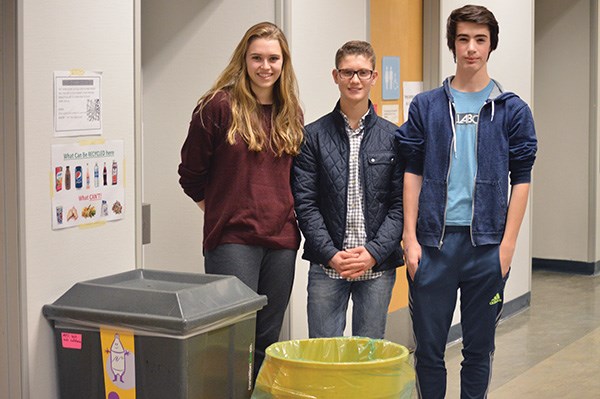A year ago, the environment club at Howe Sound Secondary attracted only a small group of students to its weekly meetings.
Now, it’s grown substantially. More students come out on Wednesdays to discuss what the school can do to leave less of an environmental footprint. “The club has probably tripled in size,” said Grade 12 student Margot Smith.
It’s no surprise that things are starting to happen in terms of action when it comes to waste reduction and other environmental initiatives at the school.
“We’ve taken a more environmental stance,” said Grade 10 student Graeme Bowers.
Teacher Kathy Cormack and her leadership students outlined a number of their projects at the board of education meeting in November. One of these is a fully functional garden at the school, which will produce vegetables as well as flowers in the school colours. Down the road, the club may look at adding a small, permanent greenhouse.
Last fall, the leadership students worked with custodial staff to conduct an audit of what the school throws out each week and how much it should be recycled.
“We did samples. We didn’t do every single garbage in the school,” said Grade 10 student Christian Smith.
What they found was that the school tosses out an estimated 85 bags of garbage each week at the school. Of this, only 16 to 17 per cent is actual waste.
Before they started, they had hoped to stick the average number of full bags in a school room to illustrate how much they throw out, but in the end they did not have enough space, as the amount far exceeded what they could stuff inside.
What they found was that based on an ideal figure of 16 per cent of material as non-recyclable, the school should have only been throwing out 13 bags of garbage each week. Instead, they found an average of 85 bags were going into landfill.
In response, the students have been working to raise awareness of the issue throughout the school community.
“We did a little commercial and put that on announcements during Waste Reduction Week,” said Grade 11 student Alexandra Jevons.
As well, the club made posters to let people know what can be recycled at the school and what cannot.
One of the plans is to get better collection system in the halls and classrooms for different materials. At present, the school has many drink container receptacles but few bins for reusable materials. At the board meeting, the school presented its numbers: nine paper bins, two plastic bins, 33 containers for bottles and cans, and 28 garbage bins.
“Right now you just throw it in the garbage because you have to go looking around if you want to recycle,” Bowers said.
The hope is that they can set up a four-container system throughout the school that would include receptacles for beverage containers, paper, plastic and garbage, side by side, to make it easy for everyone to separate materials.
Ideally, they would like a fifth container in the system for compost, but the students say this could be more complicated in terms of disposal.
As to what happens with the bottles, other leadership groups – currently, the athletic leadership students, and at the end of the year, Aboriginal leadership students – will help by sorting and returning bottles.
“We recycle every week on Friday, and we recycle all the bins around the school,” said Grade 12 student Alex Wade.
The athletic leadership students have noticed some improvement when it comes to students using the right bins for bottles and cans.
“At the beginning, a lot of this was in the garbage cans,” said Grade 11 student Harjot Thandi.
Another obvious target at a school is paper. This fall, leadership students Jasmin Grewal, Sukhpreet Rai, Harbir Atwal and Salena Dhillon, all in Grade 12, have been spearheading an effort to reduce the school’s use of paper. They started by tallying up how much Howe Sound Secondary is using.
“The goal was to reduce it,” said Grewal.
Based on the number of boxes and sheets per box, the students determined the school was using 600,000 sheets of paper a year, though they estimated the number is likely higher because they did not have all the receipts at the time they did the calculation. They would like to see the amount drop by 200,000 sheets a year.
Their plan is to get the school to cut back through alternatives such as buying recycled paper, printing on both sides of sheets or using online tools such as Google Drive instead of printed handouts for work. They presented their ideas to staff.
“In the weeks after, we saw significant changes,” Rai said.
At present, the students are trying to send their peers the same message and are conducting a survey of student habits.
As to what inspired them to go green, the students give some credit to their teacher, Cormack.
“She wanted an environmental aspect on at least one of our projects,” Atwal said.




